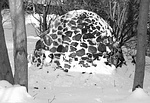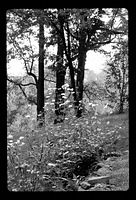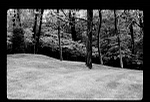The Genius of the Place -- A Portrait of Judy Tomkins
“Consult the genius of the place in all;
That tells the waters or to rise, or fall;
Or helps th' ambitious hill the heav'ns to scale,
Or scoops in circling theatres the vale;
Calls in the country, catches opening glades,
Joins willing woods, and varies shades from shades,
Now breaks, or now directs, th' intending lines;
Paints as you plant, and, as you work, designs.”
Alexander Pope, from Epistles to Several Persons: Epistle IV to Richard Boyle, Earl of Burlington
Walking through our hamlet, one notices piles of stones here and there stacked with care into smooth, graceful domes. Of differing sizes and ages, they emanate a gentle presence. One suspects a connection among them; that they are markers of important events or places, and so it turns out to be. They are the signature of Judy Tomkins, landscape designer; the unmistakable sign that one is looking upon her work.
When Judy was a teenager, she lived for a time in Nyack, with her mother. Her classmate, Caroline Abel (later Caroline Lalire) who lived on Heyhoe Woods Rd., suggested one October that they go Halloweening together. Judy recalls sniffing a little at this idea, being sophisticated even at age 13, but Caroline prevailed and they went that evening to Sneden’s Landing.
Judy and Caroline walked down Washington Spring Road past the Walden’s and crept around to the back of the Captain Joshua Martin house where the young architect Rex Allen lived with his mother. The girls peered through the dining room window to see Rex’s mother seated at the piano, dressed in a long black gown. Mrs. Allen rose stiffly from the bench and as she slowly turned toward the girls, the suspense became more than they could tolerate, and they ran screaming back up the road. Once at a safer distance, Judy said to her friend, “One day I will live in that house.”
Half a Century of Careful Cultivation
And now, Judy Tomkins is nearing 50 years ‘in that house,’ presenting us with an opportunity to reflect on her life and her contribution to our community.
Judy says that the circumstances in which you find yourself help to determine what happens to you. Her own life is a perfect example. She married the actor Henry Jones; they lived in Bucks County, where she learned to garden, and from where he had terrible commutes to New York City. She called her mother in Nyack to ask if there might be a place in the area closer to Broadway. Her mother in turn mentioned the problem to her friend Anne Gugler, who was living in Sneden’s Landing at the time, in the house next door to the Joshua Martin house. Anne reported that it was empty. Judy and her husband rented it and moved in.
The story was not really as simple as this. Later, the marriage ended, and Judy moved to New City. During this period, she met and married Calvin Tomkins, the art critic for the New Yorker, and on hearing that the house had opened up again, she arranged to buy it. This time she settled in for good.
An Eye for Images and Intimate Landscapes
In addition to her work as a landscaper, Judy has had a distinguished career in photography. She has published two volumes of her work, The Other Hampton, with text by Calvin Tomkins, and Coming Back (both of which are in the local authors’ collection at the Palisades Library). Her work has been shown by the legendary Leo Castelli Gallery in New York City, and she is represented in the permanent collection of the Metropolitan Museum of Art. Even so, she contends that her photography has not provided her with a sense of defining achievement, and it is landscaping that gives her a sense of having made a unique contribution.
A visitor to her home is struck by the powerful intimacy of her work. She explains that she is just interested in life. As she talks, the piercing intellect behind this somewhat bland statement is evident, and everything about her and around her takes on a richer tone. One peers at a photo of a party seated around her dining room table; isn’t that Jasper Johns at the end? And that has to be Leo Castelli with his back to the books, and Julio Lazzer with his head turned toward the camera.
A friend of almost twenty years, Lisa Rinehart, notes that Judy has made an art of living passionately; her house is an expression of her impeccable taste and accomplishment. The rooms draw you in, like the paths in her gardens, and each one offers its own mood. There are unexpected views of the river, of the woods, and the sky. In her living room, one’s eye is drawn to her lawn, sensuous in the winter light, framed by the dining room window, the same window through which she peered at Rex Allen’s mother so many years ago.
Judy says there is a strong connection between her photography and her landscaping. She is blessed with a mental canvas; she was always able to get her shot by the third frame, and now when she walks onto a property, she can ‘see’ what it will be. Merce Cunningham’s work is especially important to her; she sees his dancers as if they were on a canvas moving through a landscape. She shows me a picture taken of her lawn by the landscape photographer, Karen Bussolini, and it does indeed appear that the trees are choreographed with an angular awareness of each other.
A Practical Vigor – Pull It Out!
When asked to describe her philosophy of landscape design, she replies with energy, “First, pull out all the pachysandra!” Then, one has to understand the original feeling of the place, to allow it to reveal its genius. This requires accepting its innate character and not imposing oneself upon it. What has grown naturally in a place may offer the key to unlocking its mystery. She will walk the land on a new project to get its ‘feel’ and learn how the owners live on it. Then she needs to be left alone, to allow the land to take shape on the canvas of her mind. She never develops ‘plans.’
She has a propensity for ignoring limitations set on her artistic vision and can forget where one property ends and another begins. Usually, all parties are happy with the result, although sometimes it has to be explained. She laments the cutting down of old trees and derides what she calls ‘Yellow Pages’ landscaping, “you know, where people just stick in one of everything..”
One has only to walk through her landscapes to grasp her meaning. Here is one garden nestled into the cliffs of the palisades as they rise up from the water, the rock unexpectedly comforting and protective. Another scrambles up the boulders to provide expansive views of the river. A third is in intimate communion with the surrounding woods. In each one of them, a pleasant accord exists between human and nature.
As one’s eye adjusts, other themes emerge, the inviting path, the pergola and the stone shed and one becomes aware of them all over the hamlet; one is also aware of the profound influence Judy has had on the creation and preservation of what makes our hamlet unique. Another friend, Roger Hooker, observes that Judy is “emblematic of the place, of the genius of the place.”
Judy Tomkins’ gardens will be featured in the May issue of Martha Stewart Living magazine, and she is currently working on her memoirs.





